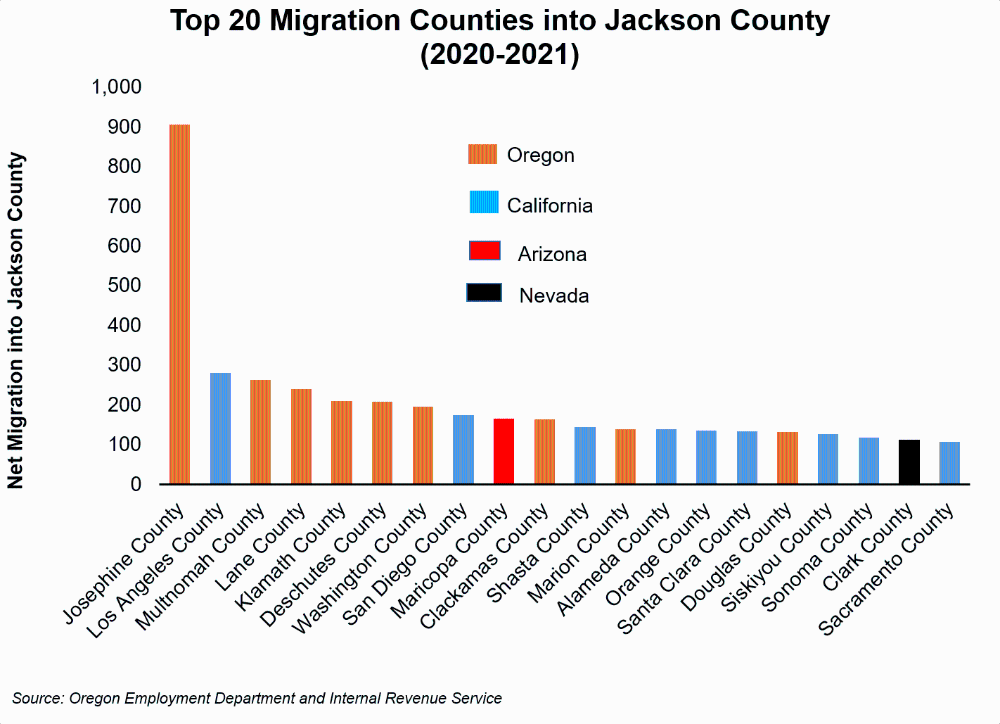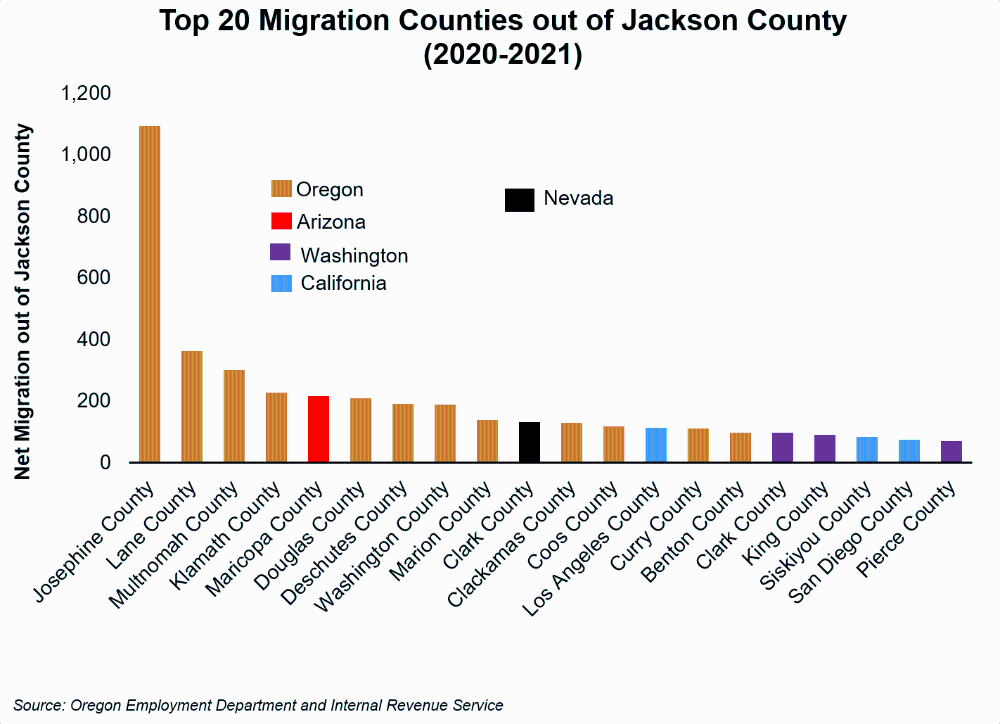Internal Revenue Service Migration Data Show Mixed Trends in the Rogue Valley
July 15, 2024The 2021-2022 migration patterns were recently released by the Internal Revenue Service (IRS). Migration data for the United States are based on year-to-year address changes reported on individual income tax returns filed with the IRS. They present migration patterns by state or by county for the entire United States and are available for inflows – the number of new residents who moved to a state or county and where they migrated from, and outflows – the number of residents leaving a state or county and where they went.
These migration patterns show the number of returns and exemptions (a good proxy for people) that filed their federal taxes in a different county from the previous year. Not only can this data help show the volume of migrants into or out of the Rogue Valley, but it also reveals the county of origin for those moving here. On the other hand, we can also track where folks move when they file their taxes with a different address than their prior year’s tax return.
Between 2021 and 2022 Oregon had 115,122 individuals out-migrate from Oregon and 108,226 migrate to Oregon, for a net loss of -6,896. Net migration was negative in Jackson County in 2021 and again in 2022. The county shed nearly 450 exemptions from 2020, and another 504 between 2021 and 2022. In other words, over the most recent year available there were 8,697 exemptions that migrated to Jackson County and 9,201 exemptions who migrated out of Jackson County, for a net migration loss of 504 exemptions or people.
Of the 8,697 who migrated to Jackson County, 5,512 came from a different state and 3,185 came from a different county in Oregon. Among the 9,201 who migrated out of Jackson County, 5,856 left for a different state and 3,345 migrated to a different county in Oregon. In other words, Jackson County lost residents both to other counties in Oregon and other states in greater numbers than migrated here from those areas.
The IRS data showed a larger decline in residents compared to the estimate from the Portland State University (PSU) Population Research Center, but a significantly smaller decline compared to the Census Bureau estimate. Population estimates from PSU show net decrease of 195 residents in Jackson County from July 1, 2021 to July 1, 2022 – a smaller decline than estimated by the IRS data. The Census Bureau, on the other hand, had a much higher estimate, showing a roughly 2,700 population decline for that year.
There are several factors which could contribute to differences between the IRS data and other population estimates. The population estimates do not cover identical timeframes as the IRS tax year data. Additionally, not everyone who migrated to or from an area may have filed taxes during the period the IRS collects data. Late filers would be excluded from the annual IRS migration data.


Net migration remained slightly positive in Josephine County in 2022. The county netted 163 exemptions from 2021 to 2022, down slightly from nearly 500 a year earlier. In other words, in 2022 there were 4,090 exemptions that migrated to Josephine County and 3,830 exemptions who migrated out of Josephine County, for a net migration gain of 163 exemptions or people.
Of the 4,090 who migrated to Josephine County, 2,195 came from a different state and 1,895 came from a different county in Oregon. Among the 3,927 who migrated out of Josephine County, 2,010 left for a different state and 1,917 migrated to a different county in Oregon.
Population estimates from Portland State University Population Research Center show net loss of 146 residents in Josephine County from July 1, 2021 to July 1, 2022 – trending slightly weaker than the IRS data. Census Bureau estimates show a population loss of 837 in Josephine County between 2021 and 2022. These newly released tax record data shows these population estimates might be a bit on the low side.
The top in-migration counties into Jackson County include many California counties, especially Southern California counties including Los Angeles, San Diego, and Riverside, and Orange County. There were a large number that moved between Jackson and Josephine counties from 2021 to 2022. There were 997 exemptions – people who moved from Jackson to Josephine County and 953 who migrated from Josephine to Jackson County, for a net migration loss from Jackson County of 44. California counties had 2,123 exemptions/ people migrate to Jackson County between 2021 and 2022 among the counties where data are available.
Jackson County saw the most people out-migrate to Josephine, (-953), Multnomah (-316), Lane (-342), and Klamath county (-224). Total Oregon out-migration from Jackson County among the counties with at least 20 tax returns filed was 3,345 in 2021. There were 715 Jackson County exemptions/ people who out-migrated to California among the counties where data are available.
The top Josephine County in-migration counties include many in California, but the top county was Jackson, where 953 residents migrated to Josephine County. Other Oregon counties where people moved from and to Josephine County were Douglas (+128), Multnomah (+90), Lane (+85), and Klamath (+82). The California in-migration effect is quite apparent looking at the top net in-migration counties in 2022, with Los Angeles, San Diego, and Orange County having the 3rd, 4th, and 10th greatest number of people migrating to Josephine County.

Looking at out-migration in Josephine County, 9 of the top 10 counties where people moved from were to other Oregon Counties, with counties in other states including Maricopa County, Arizona receiving 78 out-migrants and Los Angeles County, California seeing 23 residents migrate from Josephine County in 2022.

We have seen faster population growth coming out of the Great Recession but that has slowed in the past few years as home prices have now spiked past pre-recession peaks. Rising interest rates in the past couple years have made it more expensive to switch homes if you are financing a residence through a mortgage. Longer-term forecasts for Oregon show a resumption of population growth through in-migration rather than natural population increase. The June 2024 Economic and Revenue Forecast from the Oregon Office of Economic Analysis notes “The annual net migration was negative between 2020 and 2021 and is expected to recover after 2024. Between 2023 and 2033 net migration is expected to be in the range of 22,302 to 34,280, averaging 30,260 persons annually with net migration rate ranging between 5.18 to 7.57 per thousand population. On the other hand, if these migration trends remained suppressed, we may see something more like the zero-migration scenario that is hypothesized here in the December Economic and Revenue Forecast, beginning on page 12.
A Few Notes About IRS Migration Data
The data are available for Filing Years 1991 through 2022 and include:
- Number of returns filed, which approximates the number of households that migrated
- Number of personal exemptions claimed, which approximates the number of individuals
- Total adjusted gross income, starting with Filing Year 1995
- Aggregate migration flows at the State level, by the size of adjusted gross income (AGI) and age of the primary taxpayer, starting with Filing Year 2011.
IRS Statistics of Income’s migration data for the United States are based on year-to-year address changes reported on individual income tax returns filed with the IRS. They present migration patterns by State and county and are available for inflows – the number of new residents who moved to a State or county and where they migrated from, and outflows – the number of residents leaving a State or county and where they went. The data also include tabulations on the number of non-migrant returns within a State and county. Data do not represent the full U.S. population because many individuals are not required to file an individual income tax return.
Changes to the Migration Data Disclosure Protection Procedures
The State totals and header rows were removed from all county files. State totals can now only be obtained from the State files. Counts below 20 at the county level will now be deleted. Previously, counts below 20 were moved to a similar category in another county within the State. Data will be removed from the state files only if the counts are below a threshold of 10 returns. Records may be removed at the county level that are not removed at the state level. As such, the county totals may not add to the state totals. From more information and to download the data, go to https://www.irs.gov/statistics/soi-tax-stats-migration-data.